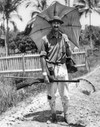Portal:Paleontology
|
The Palaeontology Portal
Introduction Paleontology (/ˌpeɪliɒnˈtɒlədʒi, ˌpæli-, -ən-/ PAY-lee-on-TOL-ə-jee, PAL-ee-, -ən-), also spelled palaeontology or palæontology, is the scientific study of life that existed prior to, and sometimes including, the start of the Holocene epoch (roughly 11,700 years before present). It includes the study of fossils to classify organisms and study their interactions with each other and their environments (their paleoecology). Paleontological observations have been documented as far back as the 5th century BC. The science became established in the 18th century as a result of Georges Cuvier's work on comparative anatomy, and developed rapidly in the 19th century. The term has been used since 1822 formed from Greek παλαιός ('palaios', "old, ancient"), ὄν ('on', (gen. 'ontos'), "being, creature"), and λόγος ('logos', "speech, thought, study"). Paleontology lies on the border between biology and geology, but it differs from archaeology in that it excludes the study of anatomically modern humans. It now uses techniques drawn from a wide range of sciences, including biochemistry, mathematics, and engineering. Use of all these techniques has enabled paleontologists to discover much of the evolutionary history of life, almost all the way back to when Earth became capable of supporting life, nearly 4 billion years ago. As knowledge has increased, paleontology has developed specialised sub-divisions, some of which focus on different types of fossil organisms while others study ecology and environmental history, such as ancient climates. (Full article...) Selected article on the prehistoric world and its legaciesCoal balls, despite their name, are calcium-rich masses of permineralised life forms, generally having a round shape. Coal balls were formed roughly 300 million years ago, during the Carboniferous Period. They are exceptional at preserving organic matter, which makes them useful to scientists, who cut and peel the coal balls to research the geological past of the Earth. In 1855, two English scientists, Joseph Dalton Hooker and Edward William Binney, discovered coal balls in England, and the initial research on coal balls was carried out in Europe. It was not until 1922 that coal balls were discovered and identified in North America. Since then, coal balls have been discovered in other countries and they have led to the discovery of over 300 species and 130 genera. Coal balls can be found in coal seams across North America and Eurasia. North American coal balls are relatively widespread, both stratigraphically and geologically, as compared to coal balls from Europe. The oldest known coal balls were found in Germany and the former Czechoslovakia. Did you know?

General images -The following are images from various paleontology-related articles on Wikipedia.
Selected article on paleontology in human science, culture and economics
William Beebe was an American naturalist, ornithologist, marine biologist, entomologist, explorer, and author. He is remembered for the numerous expeditions he conducted for the New York Zoological Society, his deep dives in the Bathysphere, and his prolific scientific writing for both academic and popular audiences.
Born in Brooklyn, New York Beebe left college before obtaining a degree in order to work at the then newly opened New York Zoological Park, where he was given the duty of caring for the zoo's birds. Beebe participated in a series of research expeditions, including one intended to document the world's pheasants. He published an account of his pheasant expedition titled A Monograph of the Pheasants. During the course of his expeditions Beebe gradually developed an interest in marine biology, ultimately leading to his 1930s dives in the Bathysphere off the coast of Bermuda. These dives represented the first time a biologist observed deep-sea animals in their native environment. Later, Beebe returned to the tropics and founded a tropical research station which remains in operation as part of the Asa Wright Nature Centre. Beebe's research there continued until his death in 1962. He is also remembered for several theories he proposed about avian evolution which are now regarded as having been ahead of their time, particularly his 1915 hypothesis that the evolution of bird flight passed through a four-winged or "Tetrapteryx" stage, which has been supported by the 2003 discovery of Microraptor gui. (see more...) On this day...May 8:
Euoplocephalus tutus and the Diversity of Ankylosaurid Dinosaurs in the Late Cretaceous of Alberta, Canada, and Montana, USA Victoria M. Arbour, Philip J. Currie published 08 May 2013 An Additional Baurusuchid from the Cretaceous of Brazil with Evidence of Interspecific Predation among Crocodyliformes Pedro L. Godoy, Felipe C. Montefeltro, Mark A. Norell, Max C. Langer published 08 May 2014 Selected image
CategoriesTopicsGeneral - Paleontology - Fossil - Evolution - Extinction Quality ContentFeatured paleontology articles
- Achelousaurus
- Acrocanthosaurus
- Albertosaurus
- Allosaurus
- Amargasaurus
- Ankylosaurus
- Apatosaurus
- Archaeopteryx
- Baryonyx
- Carnotaurus
- Catopsbaatar
- Ceratosaurus
- Chicxulub Crater
- Compsognathus
- Cretaceous–Tertiary extinction event
- Daspletosaurus
- Deinocheirus
- Deinonychus
- Deinosuchus
- Dilophosaurus
- Dinosaur
- Diplodocus
- Dromaeosauroides
- Edmontosaurus
- Elasmosaurus
- Giganotosaurus
- Gorgosaurus
- Herrerasaurus
- Iguanodon
- Istiodactylus
- Lambeosaurus
- List of dinosaur genera
- Majungasaurus
- Massospondylus
- Megalodon
- Nemegtomaia
- Nigersaurus
- Opisthocoelicaudia
- Paranthodon
- Parasaurolophus
- Plateosaurus
- Psittacosaurus
- Seorsumuscardinus
- Spinosaurus
- Stegosaurus
- Stegoceras
- Styracosaurus
- Tarbosaurus
- Thescelosaurus
- Triceratops
- Tyrannosaurus
- Velociraptor
Things you can doCurrent Paleontology FACs - None yet... WikiProjectsRelated portalsAssociated WikimediaThe following Wikimedia Foundation sister projects provide more on this subject:
Discover Wikipedia using portals |









































